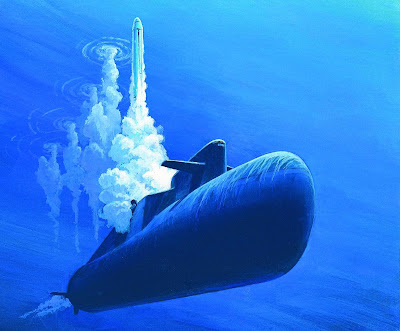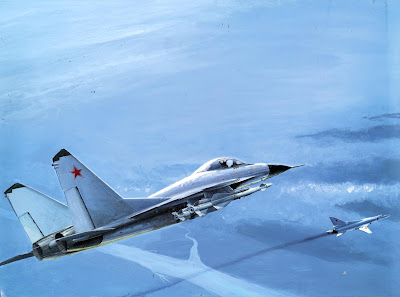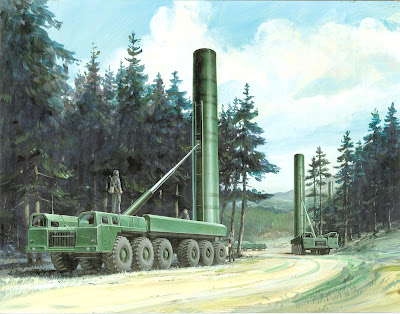Tuesday’s Roll-up of Russian Military and National Security News
 Today’s roll-up of Russian issues is pretty extensive – from a major re-write of Russian military doctrine to a threat to put BMD tracking radars on embassy and consulate grounds (in response to a pending agreement between the US, Poland and Czech Republic to deploy a portion of the US-Ground-based Mid-Course Defense system in Europe) and finish with a couple of interesting videos w/footage of the Topol-M (single and MIRV variants). Sources are many and varied and included RIA Novosti, HULIQ.com, Associated Press, BBC, The Guardian, and the Moscow Times.
Today’s roll-up of Russian issues is pretty extensive – from a major re-write of Russian military doctrine to a threat to put BMD tracking radars on embassy and consulate grounds (in response to a pending agreement between the US, Poland and Czech Republic to deploy a portion of the US-Ground-based Mid-Course Defense system in Europe) and finish with a couple of interesting videos w/footage of the Topol-M (single and MIRV variants). Sources are many and varied and included RIA Novosti, HULIQ.com, Associated Press, BBC, The Guardian, and the Moscow Times.  Re-writing Military Doctrine
Re-writing Military Doctrine
Russia is in the final stages of drafting a new military doctrine (parallel to the US’ National Military Strategy), replacing the current which is now some fourteen-years old (originally written in 1993 and revised/updated in 2000). The re-write is being led by the Russian Security Council and follows the direction of President Putin. According to the Council, the revision is needed since the “contemporary realities” have changed dramatically since 2000. An article in RIA Novosti notes that:
The doctrine lists factors that the Russian Federation perceives as potential threats, both internal and external and states support for a multi-polar world, in preference to a uni-polar world dominated by a single superpower that is quick to resort to military force.
The document also emphasizes Russia’s commitment to military reform, with continued use of conscription, but a gradual shift towards a professional army.
But since 2000, drastic changes have occurred in the geopolitical and military situation in the world and in the nature of threats against national security, which makes it necessary to revise the specific tasks facing the Russian Armed Forces and related security agencies, the Security Council said.
Russian national security experts believe that military doctrines adopted by leading global powers emphasize modernization of their military potential and the use of advanced technologies in the development of modern weaponry.
Commenting on the change, Makhmut Gareev, president of the highly influential Academy of Military Sciences, provided insight as to what the revised military doctrine might look.
-
‘Modernization Is Not Reform’ : Central to the reform are Putin’s vision for a strengthened Russian presence in the international arena — a presence that requires the modernization of the Russian Army, centralization of the defense industry under the more direct control of the Kremlin (endnote 1), and the adoption of a new military doctrine in response to NATO expansion. By 2017, according to out-going minister of defense Sergei Ivanov (and putative successor to Putin), Russia will spend 5 trillion rubles ($200 billion) on defense. Fifty percent of this sum will cover the procurement of a new system of intercontinental ballistic missiles and tactical rockets, strategic bombers, state-of-the-art air-defense systems, and advanced tanks. In addition, by 2009, Russian political and military leaders will make a decision on whether to launch a national program to build new Russian aircraft carriers. Under this plan, about 45 percent of Russia’s current stock of military hardware will be renewed by 2015. The aim of the program is to restore strategic parity with the West. Presenting his plan to the Duma, Ivanov warned that he prefers to talk “about modernization, but not reform of the army.” “Because the word ‘reform’ gives us an allergic reaction,” he explained.
-
Gareev has noted that the revised doctrine will, “drop the stipulation about Moscow’s right for a preemptive nuclear strike in order to prevent large-scale aggression.” Russia’s insistence on the right to a first strike had been based on the assumption that the Russian Army would not be able to effectively defend Russia against NATO troops.
In a presumed nod to geo-political reality, the revised doctrine will also drop as “politically unenforceable” a basic provision proclaiming Russia’s opposition to the expansion of military blocs, a veiled reference to NATO and its growing membership of former WTO states. Instead, the Russian military proposes to incorporate a statement emphasizing how, “U.S. efforts to push Russia away from the post-Soviet space [poses] a threat to Russia’s national security.”
The new doctrine will also declare that the Russian economy should provide for the army’s growth at any cost, identifying external threats, such as US ballistic missile defense deployment in Europe, as a catalyst for such funding. Given Russia’s growing revenue from oil/gas reserves (and a willingness to use the threat of cutoff of access to the same as a means of coercion) this is a not inconsiderable development. Nevertheless, there are some significant and vocal disagreements (endnote 2) over this view – spurred no doubt, by reminders of the not all distant past when the civilian economy suffered mightily in order to provide for the growth of conventional and nuclear forces under Khrushchev and Brezhnev.
All of this follows in the steps of especially harsh comments at the Munich Conference in February by President Putin, which, when summed with those of the civilian and military leadership, signal a distinctly less cooperative if not more hostile approach to the West in general, but the US in particular. Of course, as in the US and elsewhere, one must view this through the lens of local politics and it is entirely within the realm of reason that the above is Putin playing to the Russian electorate, which has turned decidedly anti-western, in view of the upcoming election to ensure the election of his desired successor. In YHS’ view, that does not account for the range of actions witnessed in the diplomatic and military arena over the past few years. Are we on the brink of another Cold War? Not yet – but the period we are entering is one of a much pricklier relationship than that of almost two decades ago.
Russia To Put Missile Defense Elements in Embassies
(Ria Novosti, March 19, 2007). Russia could place space monitoring radars on the territory of its embassies in several countries to track the launches of ballistic missiles abroad, the commander of Space Forces said in an interview. … Commander of Russia’s Space Forces Colonel General Vladimir Popovkin said in an interview with the Space Technology News magazine that the placement of advanced quantum-optical radars at the embassies would allow Russia “to spot launches otherwise undetectable from Russian territory” and adjust the trajectories of missile “killer-vehicles” in case of a potential threat.
But the Russian general said that the deployment of U.S. missile shield elements in Central Europe enables Americans to monitor all launches of ballistic missiles from the European part of Russia and from Northern Fleet’s submarines, and to destroy these missiles in the initial stage of their flight trajectory.
“If the United States really wanted protection from Iranian missiles they would have placed a [radar] station in Turkey, also a NATO member,” Popovkin said. He said a special command center will be built at the Space Forces headquarters in Krasnoznamensk, near Moscow, to exercise a centralized remote control of new compact radars at Russian embassies. “We will use dedicated radio frequencies to program and re-program monitoring radars that will require token technical maintenance,” the general said.
Again, YHS believes this to be mostly rhetoric, especially given some of the mirror-language found in the above statement. One would be hard pressed to believe that host nations would allow the emplacement of powerful radars in the midst of major metropolitan centers with the EM radiation hazard they would entail. Additionally, situation of said locations would also be less than optimal as well. Verdict – grist for the propaganda mill…
Interesting footage from Russian TV of mobile- and silo-based launches of the SS-25 and SS-27 ariants (single and MIRV). Also some pointed commentary and visuals re. ability to outmatch the US BMDS…
ENDNOTES:
_________________________________________________________
(1) One of the first indicators of this was late last month; Putin signed a decree creating the United Aviation Corporation, which combines all national civilian and military aircraft companies, including MiG, Sukhoi, Tupolev, and Ilyushin. First Deputy Prime Minister Ivanov will chair the new corporation. Aviation experts believe that Ivanov is trying to save the floundering civilian aircraft sector by putting it together with advanced military aircraft building. Implications for future dvelopments, such as the Su-35 and the competition for India’s new multi-role combat aircraft (with Boeing and MiG entries leading the field of candidates) are, to say the least, interesting… A similar merger plan was announced for Russia’s shipbuilding industry. According to the plan, Russia will combine all of its 160 shipyards and shipbuilding facilities into three big holding companies, the biggest of which will be the United Industrial Company, also chaired by Ivanov. Military ship producers currently make up 77 percent of the Russian shipbuilding sector.
(2) Andrei Neshchadin, deputy director of the Social-Conservative Club, a think tank connected to the pro-Putin Unified Russia party, said that oil revenues may not be sufficient to finance the defense modernization program. He notes that while Russia produces a large amount of oil relative to other countries, it is also a much larger country with a much larger population to take care of: “We produce only 3 tons of oil per capita, while Norway produces 20.” In other words, Russia, despite its abundant energy reserves, will never be wealthy enough to modernize the army on petrodollars alone. Neshchadin, however, provided Moscow policymakers with a way to manage this challenge. He noted that “in order to make the population ready for such a sacrifice, state propaganda would need to publicize external threats such as the [U.S.] deployment of a ballistic missile defense system in Poland and the Czech Republic or the prospect of uncontrolled immigration from [Russia’s southern and eastern borders].”


One Comment
Comments are closed.